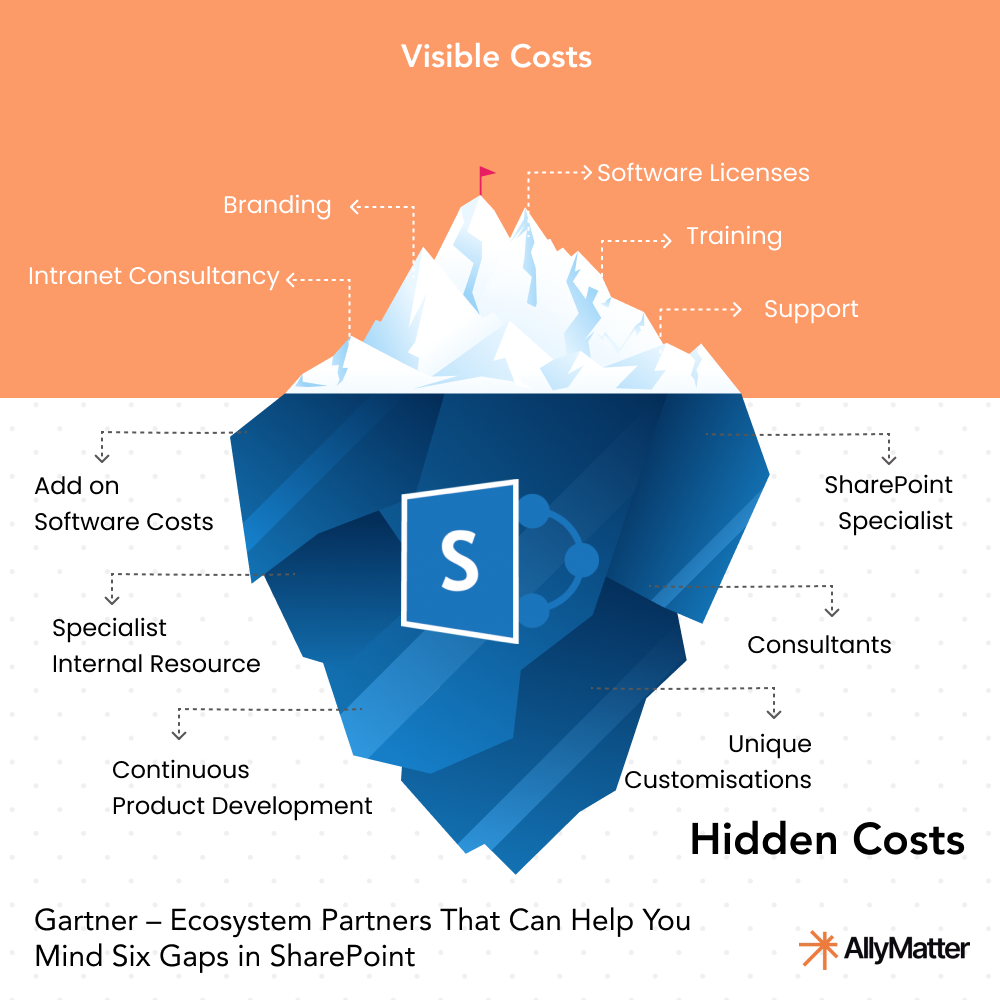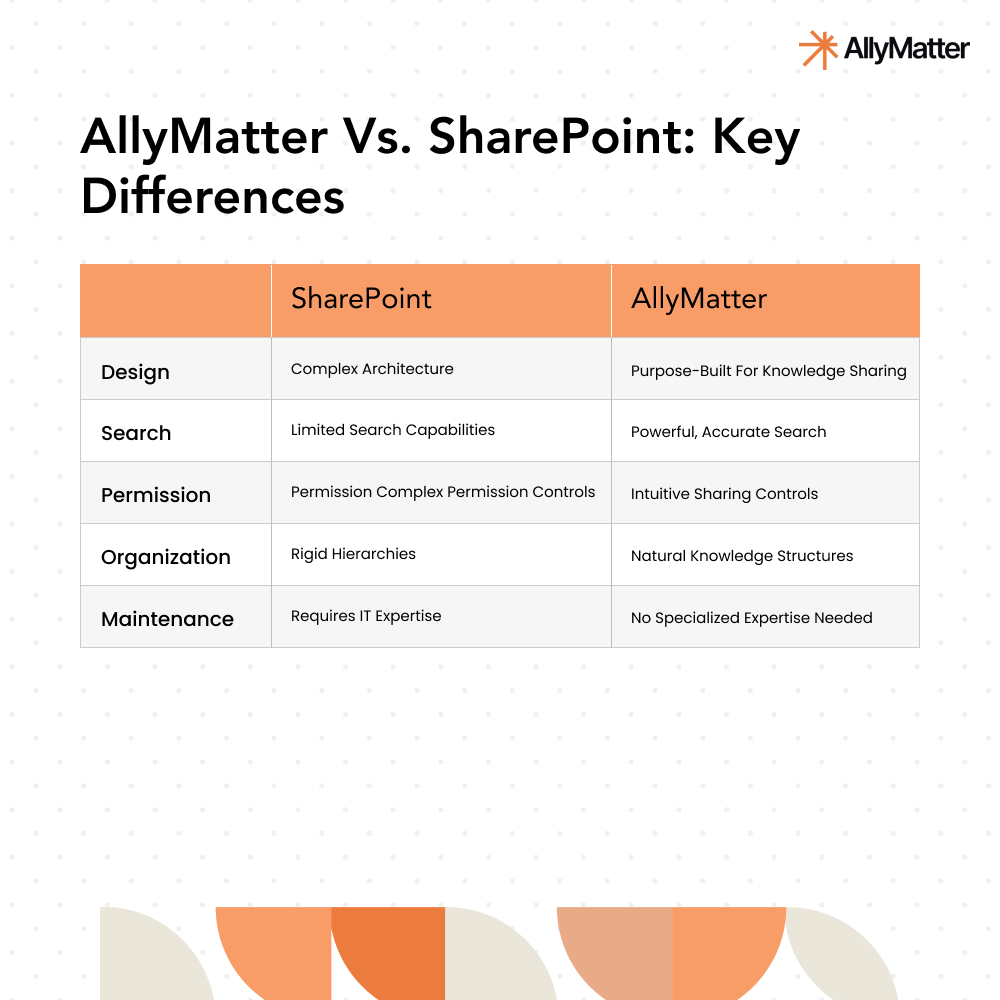
In today’s knowledge-driven workplace, employees need quick and reliable information to work efficiently and make informed decisions. Therefore, an effective internal documentation system is crucial for organizational success. While SharePoint is widely adopted for document management, it falls short as a dedicated knowledge base solution. Here’s why companies should consider alternatives when building their internal knowledge repositories.
Search and content discovery issues
Non-indexable content
SharePoint struggles with indexing certain content types and formats, making critical information difficult to find through search.
For instance, content within embedded objects, certain PDF files, and custom web parts often remains invisible to SharePoint’s search engine. This creates knowledge blind spots where valuable information exists but remains effectively hidden from users.
Poor search capabilities
Even when content is indexed, SharePoint’s search functionality lacks the precision and relevance ranking of dedicated knowledge base platforms.
Users frequently encounter irrelevant search results or miss crucial information because SharePoint’s algorithm doesn’t effectively prioritize content based on relevance, recency, or user behavior. This forces employees to rely on folder navigation rather than search, dramatically reducing efficiency.
According to a Gartner survey, 47% of digital workers struggle to find the information needed to effectively perform their jobs. SharePoint’s indexing limitations may contribute significantly to this challenge.
User experience challenges
Overwhelming interface
SharePoint’s complex interface intimidates non-technical users, creating barriers to adoption and effective use.
The multiple menus, ribbons, and configuration options create cognitive overload for casual users who simply need to find information quickly. This complexity discourages regular use and prevents SharePoint from becoming the go-to resource it should be.
Steep learning curve
New users require significant training to navigate and utilize SharePoint effectively.
Organizations typically need to invest in formal training sessions and create extensive user guides just to ensure basic competency. This represents a hidden cost beyond licensing and infrastructure, as valuable employee time is diverted to system training rather than core responsibilities.
Outdated interface
Despite updates, SharePoint’s core interface design concepts lag behind modern, intuitive knowledge management systems.
The interface reflects its enterprise IT origins rather than consumer-grade user experience design. Compared to modern knowledge platforms that prioritize simplicity and intuitive navigation, SharePoint feels clunky and dated to today’s users who expect consumer-app levels of usability.
Poor mobile experience
Limited functionality on mobile devices restricts access to knowledge when team members are away from their desks.
The SharePoint mobile app offers only a subset of desktop features, and the interface doesn’t adapt well to smaller screens. This limitation becomes increasingly problematic as workforces become more distributed and mobile-dependent.
Administrative headaches
Complex permission management
Creating appropriate access levels becomes more difficult as organizations grow.
Setting up logical permission structures requires navigating through multiple screens and understanding concepts like site collections, inheritance, and security groups. What should be simple, granting specific teams access to relevant information, often requires advanced SharePoint expertise.
Difficult maintenance
As content volume grows, maintaining organization and relevance becomes exponentially more challenging.
Without built-in content review cycles and expiration workflows, SharePoint sites commonly become digital dumping grounds filled with outdated, redundant, and sometimes contradictory information. The system lacks automated tools to identify stale content or prompt regular reviews.
Costly implementation
Beyond licensing, SharePoint requires significant investment in setup, customization, and ongoing maintenance.
Many organizations discover they need to hire consultants or dedicate internal IT resources just to create a functional knowledge management system in SharePoint. These hidden costs can double or triple the expected budget for a knowledge base initiative.

Specialized expertise required
Effective SharePoint management typically requires dedicated administrators with specialized training.
Unlike self-service knowledge platforms, SharePoint often becomes the domain of specialists rather than being maintained by the actual knowledge owners. This creates bottlenecks where content updates depend on technical staff’s availability rather than business needs.
Content organization problems
Weak information architecture
SharePoint lacks robust, intuitive organizational structures for knowledge management.
While SharePoint offers site templates, they aren’t optimized for knowledge base functionality. Organizations are forced to design custom information architectures, often leading to inconsistent approaches across departments or teams.
Navigation difficulties
Finding information often requires understanding complex folder hierarchies rather than intuitive topic organization.
SharePoint’s primary organization method, nested sites and libraries, creates deep hierarchies that require users to understand where content is stored rather than what it contains. This fundamental approach conflicts with how people naturally search for information.
Insufficient guided assistance
Unlike dedicated knowledge bases, SharePoint provides limited contextual help and guidance for users.
Modern knowledge platforms offer contextual recommendations, related content suggestions, and guided learning paths. SharePoint offers basic linking but lacks sophisticated tools to guide users through complex information landscapes.
Consider these warning signs that your SharePoint implementation isn’t serving knowledge needs:
- Team members regularly ask colleagues for information that should be documented.
- New employees take weeks to find basic operational procedures.
- Multiple versions of the same policy circulate via email.
- IT receives frequent requests for SharePoint training and troubleshooting.
Content quality and consistency issues
Poor version control
Tracking document versions and changes is cumbersome, leading to confusion about which information is current.
While SharePoint offers version history, it’s difficult to compare versions or understand what changed between iterations. Users frequently encounter outdated information without clear indicators of more current alternatives.
Inconsistent formatting
Without strong templates and formatting controls, documentation becomes visually inconsistent and looks less professional.
SharePoint’s editing capabilities don’t enforce consistent styles or layouts across knowledge articles. This leads to visual inconsistency that undermines credibility and makes content harder to scan and consume.
Technical limitations
Performance issues
SharePoint can become sluggish when handling large document libraries or complex site structures.
Once libraries exceed a few thousand documents, performance noticeably degrades. Search operations take longer, and navigation becomes frustratingly slow. This performance ceiling is particularly problematic for knowledge bases, which naturally grow larger over time.
Limited analytics
Understanding how documentation is being used, what’s valuable, and what needs improvement is difficult with SharePoint’s basic analytics.
SharePoint provides only basic usage statistics without the deep insights needed to optimize a knowledge base. Administrators can’t easily identify knowledge gaps, popular content, or abandoned resources without third-party tools.
Read: Using Knowledge Base Analytics to Predict Information Needs
Integration challenges
While SharePoint integrates well with Microsoft products, connecting with other essential business tools can be problematic.
Organizations using non-Microsoft tools for project management, customer support, or team communication face integration hurdles. This creates knowledge silos where crucial information remains disconnected from the systems where work actually happens.
Strategic drawbacks
Not purpose-built
Unlike dedicated knowledge base platforms, SharePoint wasn’t designed specifically for knowledge management workflows.
It was built as a document management and collaboration platform, not a knowledge base. This fundamental mismatch means that every knowledge management implementation requires extensive customization to overcome SharePoint’s default behaviors.
Internal focus
SharePoint works primarily as an internal tool, making it difficult to selectively share knowledge with external stakeholders.
When trying to share documentation with clients or partners, administrators must navigate complex permission settings that weren’t designed with external sharing in mind. Organizations typically need to create special external sharing links that require constant management as they expire or need updating.
This complexity frequently leads to security concerns, as proper permissions management becomes increasingly difficult to maintain. Unlike dedicated knowledge base platforms with built-in public/private toggles for specific content sections, SharePoint forces difficult choices between accessibility and security.
Limited online features
SharePoint Online offers fewer capabilities than some on-premises versions while introducing new limitations.
Organizations moving to SharePoint Online often discover that custom solutions built for on-premises deployments don’t transfer cleanly to the cloud version. This creates painful migration challenges and sometimes forces abandonment of previously functional knowledge management approaches.
Costly licensing
Advanced features often require premium licenses, increasing the total cost of ownership.
Many knowledge base features that come standard in dedicated platforms require premium SharePoint licenses or add-ons. This creates unexpected costs when organizations discover basic functionality isn’t available in their current licensing tier.
The AllyMatter approach to knowledge sharing
AllyMatter offers a purpose-built solution that addresses each of SharePoint’s fundamental knowledge management limitations. Unlike SharePoint’s complex architecture, AllyMatter was designed from the ground up specifically for internal documentation and knowledge sharing.
The platform features powerful, accurate search capabilities that index all content types, ensuring critical information is always findable. Its intuitive interface requires minimal training, allowing team members to start creating and consuming knowledge immediately without extensive onboarding.
AllyMatter simplifies permission management with straightforward controls for internal and external sharing. Organizations can selectively share specific documentation with clients or partners without complex configuration or security concerns. This flexibility allows for secure collaboration while maintaining appropriate boundaries.
Content organization in AllyMatter follows natural knowledge structures rather than rigid hierarchies. The system offers guided assistance with contextual recommendations and clear navigation paths, helping users discover relevant information beyond their initial query.
Perhaps most importantly, AllyMatter requires no specialized expertise to maintain. Content owners can directly manage their documentation without depending on IT resources, ensuring knowledge stays current without administrative bottlenecks.

Moving beyond SharePoint’s limitations
While SharePoint has its place in document management and collaboration, its fundamental architecture and design make it poorly suited for creating effective internal knowledge bases. Organizations serious about knowledge management should explore purpose-built alternatives that better support their documentation needs.
The most successful knowledge management initiatives start with selecting the right tool for the job. For most organizations, that tool simply isn’t SharePoint.
Ready to move beyond SharePoint’s limitations? Join our waitlist to experience how purpose-built knowledge management transforms your team’s productivity.
Frequently asked questions
Can we migrate our existing SharePoint content to a dedicated knowledge base platform?
Yes, most modern knowledge management platforms offer migration tools and services to transfer your existing SharePoint content. The process typically involves exporting documents, preserving metadata, and restructuring content to match your new platform’s organization. While migration requires planning, it’s often less complex than continuing to work around SharePoint’s limitations.
What’s the typical cost difference between SharePoint and purpose-built knowledge base solutions?
While SharePoint appears cost-effective due to existing Microsoft licensing, hidden costs often emerge. These include IT consulting for setup, ongoing maintenance, training expenses, and premium licenses for advanced features. Purpose-built platforms often provide better total cost of ownership through reduced implementation time and self-service capabilities.
How do we convince leadership to move away from SharePoint when it’s already part of our Microsoft ecosystem?
Focus on productivity metrics and user adoption rates. Calculate time lost to search inefficiencies and training overhead. Demonstrate how purpose-built solutions integrate with existing Microsoft tools while solving specific knowledge management challenges that SharePoint cannot address effectively.
Will switching from SharePoint disrupt our existing workflows and integrations?
Modern knowledge base platforms are designed to integrate seamlessly with popular business tools, including Microsoft applications. Most transitions actually improve workflows by eliminating the bottlenecks and workarounds that SharePoint often requires. The key is choosing a platform that connects with your existing tools rather than replacing them entirely.
How long does it typically take to see ROI after moving away from SharePoint for knowledge management?
Organizations often see immediate improvements in user satisfaction and search efficiency within the first month. Measurable productivity gains typically emerge within 60-90 days as team members spend less time searching for information and more time on core responsibilities. The elimination of IT support requests for SharePoint issues also provides quick cost savings.


